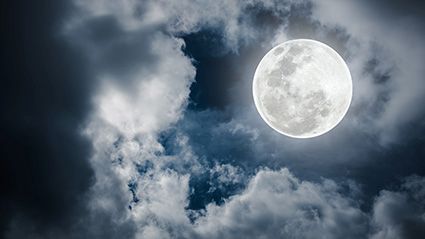WEDNESDAY, Jan. 27, 2021 (HealthDay News) — Moonlight feels right, the ’70s song insists — and that old nugget might have been onto something.
Your sleep waxes and wanes with the phases of the moon, with folks staying up later when moonlight is strongest, researchers discovered by comparing primitive human tribes to college students.
“Sleep starts later and lasts less on the three or five nights that are before the full moon. On those nights, sleep tends to be shorter,” said senior researcher Horacio de la Iglesia, a professor of biology with the University of Washington in Seattle.
Your best sleep? That appears to be during the few nights just before the new moon, when there’s the least moonlight, de la Iglesia added.
The research team figured this out by tracking sleep patterns among nearly 100 members of the indigenous Toba/Qom community in the Argentinian province of Formosa.
The Toba/Qom were split among three groups living in different conditions. One rural community had no access to electricity, a second had only limited access, while a third lived in an urban setting with full access to electricity.
The team also analyzed sleep data from more than 450 University of Washington students.
Everyone’s sleep cycles fluctuated with the phases of the moon, researchers found.
Depending on the community, the total amount of sleep varied across the lunar cycle by an average of 46 to 58 minutes, and bedtimes seesawed by around 30 minutes.
“Although the effect is more robust in communities without access to electricity, the effect is present in communities with electricity, including undergraduates at the University of Washington,” de la Iglesia said.
The results from college students were particularly surprising, he said, because there’s little reason to think people in urban settings would know off the top of their heads whether it was a full, new, half or quarter moon out on any given night.
It’s been known for some time that light plays a crucial role in the human circadian system, said Dr. Steven Feinsilver, director of the Center for Sleep Medicine at Lenox Hill Hospital in New York City. He was not part of the study.
“There are specific cells in the eye that sense blue light, which were not known of until about 20 years ago,” Feinsilver said, referring to the light shining from TVs, smartphones and computer screens. “They’re not very involved in vision, they don’t do much for vision, but they send signals to the brain saying ‘Lights are on, time to be awake,’ ‘Lights off, time to be asleep.'”
The waxing moon grows increasingly brighter as it progresses toward a full moon, and generally rises in the late afternoon or early evening, placing it high in the sky during the evening after sunset, researchers noted.
“We know that light’s important, and maybe this is an example that even moonlight is important,” Feinsilver continued.
De la Iglesia said early human sleep cycles might have adapted to take advantage of the illumination provided by moonlight to work and socialize later into the night. And now it’s developed into a built-in trait in modern man.
“That’s exactly what we do with artificial light. We extend the end of the day,” de la Iglesia said. “And that’s exactly what we saw people do with moonlight.”
These findings could have practical implications for people with sleep problems, de la Iglesia said.
“If your doctor gives you a list of practices you should follow to improve your sleep starting — like don’t get exposed to bright light, avoid screens, avoid highly stimulating media — maybe on the nights that proceed the full moon you could be a little more proactive with those measures because you know ahead of time that those nights are going to be particularly harder,” he said.
The new study appears Jan. 27 in the journal Science Advances.
More information
The U.S. Centers for Disease Control and Prevention has tips for better sleep.
SOURCES: Horacio de la Iglesia, PhD, professor, biology, University of Washington, Seattle; Steven Feinsilver, MD, director, Center for Sleep Medicine, Lenox Hill Hospital, New York City; Science Advances, Jan. 27, 2021
Copyright © 2025 HealthDay. All rights reserved.

